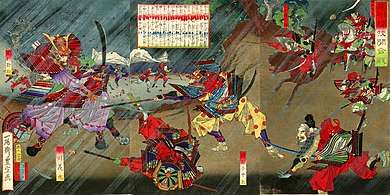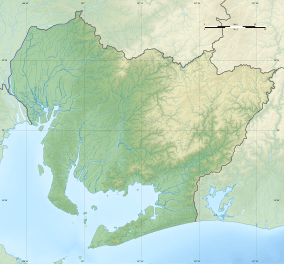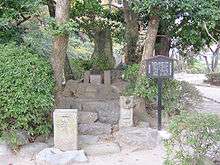Battle of Okehazama
The Battle of Okehazama (桶狭間の戦い, Okehazama-no-tatakai) took place in June 1560. In this battle, Oda Nobunaga defeated Imagawa Yoshimoto and established himself as one of the front-running warlords in the Sengoku period.[2]
| Battle of Okehazama | |||||||||
|---|---|---|---|---|---|---|---|---|---|
| Part of the Sengoku period | |||||||||
 Ukiyo-e of the Battle of Okehazama by Utagawa Toyonobu | |||||||||
| |||||||||
| Belligerents | |||||||||
|
|
| ||||||||
| Commanders and leaders | |||||||||
|
|
| ||||||||
| Strength | |||||||||
| 25,000[1] | ~2,000–3,000 | ||||||||
 Location within Aichi Prefecture  Battle of Okehazama (Japan) | |||||||||
Background
In June 1560, Imagawa Yoshimoto, a powerful warlord who controlled Suruga, Tōtōmi, and Mikawa Provinces amassed an army of 25,000 men to march on Kyoto to challenge the increasingly weak and ineffective Ashikaga shogunate for control of the country. The army followed the route of the Tōkaidō highway, and crossed from Mikawa into Owari province, which had recently been united by local warlord Oda Nobunaga. The Imagawa forces quickly overran the border fortresses of Washizu, Matsudaira forces led by Matsudaira Motoyasu took Marune fortress, and Yoshimoto set up camp at Dengakuhazama, located in the village of Okahazama, just outside of what is now the city of Nagoya. In opposition, Oda Nobunaga could field only about 2000-3000 men, or roughly one-tenth of the Imagawa army. Although some of his staff recommended withdrawing to the Oda stronghold of Kiyosu Castle, Nobunaga was aware that Kiyosu would not be able to withstand a siege, and instead stated that "only a strong offensive policy could make up for the superior numbers of the enemy", and ordered a counterattack.[3]
The geography of the area in which the Imagawa set up their camp was well known to Nobunaga and his scouts, as they had often used the area for war games in the guise of falconry hunts. Nobunaga led his men in person from Kiyosu via Atsuta Shrine to a fortified temple called Zenshō-ji, a short distance away from Okehama, on the other side of the Tōkaidō road.[4] In order to bluff any Imagawa scouts, Nobunaga ordered his men to set up numerous flags and banners around the temple to give the appearance of a much larger force.[5][6]
Battle
The actual sequence of events of the Battle of Okehazama has been much embellished by legend and is historically unclear. Traditionally it has been held that due to the vast discrepancy in numbers, the Oda army made a flanking maneuver and attacked the Imagawa army at Dengaku-hazama from the north.[6] However, due to familiarity of the Oda forces with the terrain and Nobunaga's propensity for aggressive tactics, many modern historians theorize that the attack was actually a frontal assault to Yoshimoto camp, either by design or by accident.
In any event, the Imagawa army was caught by surprise. The Imagawa were celebrating their recent easy victories, and as the afternoon was very hot, many had removed their armor. Using a thunderstorm to mask their movements, the Oda troops struck hard at the heart of the Imagawa camp, which was in a narrow valley. The surprise attack caused a panic and the Imagawa troops broke ranks and many attempted to flee.[4]
Imagawa Yoshimoto, unaware of what was transpiring, heard the noise and emerged from his tent shouting at his men to quit their drunken revelry and return to their posts. By the time he realized, moments later, that the samurai before him were not his own, it was too late to organize a defense.
Yoshimoto was attacked by Mōri Shinsuke and Hattori Koheita. Yoshimoto, Munenobu, and Naomori engaged them in melee, and parried their initial attack, but was soon overcome and killed.[7][8]
With their leader and all but two of the senior officers killed, the remaining Imagawa troops either surrendered or fled.
Aftermath
The Battle of Okehazama is regarded as one of the most significant turning points in Japanese history. The Imagawa clan was greatly weakened and would soon be destroyed by its neighbors. Oda Nobunaga gained greatly in prestige, and many samurai and minor warlords (including Imagawa's former retainer, Matsudaira Motoyasu, the future Tokugawa Ieyasu) pledged fealty.[9]
National Historic Site

In 1937, Japan's Ministry of Education designated the battlefield, Okehazama Kosenjo, a National Historic Site of Japan.[10][11] Located at Minamiyakata, Sakae-cho, Toyoake City, the site hosts The Shichikokuhyo, or Seven Granite Pillars, with each pillar representing Yoshimoto's seven warlords. The first of the pillars bears the words, "Imagawa Yoshimoto was killed here."
The battlefield is now a park.[10]
References
- (Research by Imperial Japanese Army General Staff Office)
- A Military History of Japan by John Kuehn p. 102
- Sansom, George (1961). A History of Japan, 1334–1615. Stanford University Press. p. 276. ISBN 0804705259.
- Turnbull, Stephen (1998). The Samurai Sourcebook. Cassell & Co. p. 215. ISBN 1854095234.
- Weston, Mark. "Oda Nobunaga: The Warrior Who United Half of Japan." Giants of Japan: The Lives of Japan's Greatest Men and Women. New York: Kodansha International, 2002. 140–45. Print.
- Turnbull, Stephen (1987). Battles of the Samurai. Arms and Armour Press. pp. 37–38. ISBN 0853688265.
- "1560: The Spring Thunderstorm", Geocities.yahoo.com
- Sato, Hiroaki (1995). Legends of the Samurai. Overlook Duckworth. pp. 234–37. ISBN 9781590207307.
- Turnbull, Stephen R. (1977). The Samurai: A Military History. New York: MacMillan Publishing Co. p. 144.
- "Toyoake City". Archived from the original on 2011-09-10. Retrieved 2012-12-03.
- "桶狭間古戦場伝説地" (in Japanese). Agency for Cultural Affairs.
Further reading
- De Lange, William. Samurai Battles: The Long Road to Unification. Toyp Press (2020) ISBN 978-949-2722-232
- Paterson, Les, The Battle of Okehazama, Jetlag Pressure (2008) ISBN 0979039746
- Grant, R.G. 1001 Battles That Changed the Course of History Chartwell Bookk (2017) ISBN 0785835539
External links

- Aichi Prefecture Tourist Information
- Toyoake City home page